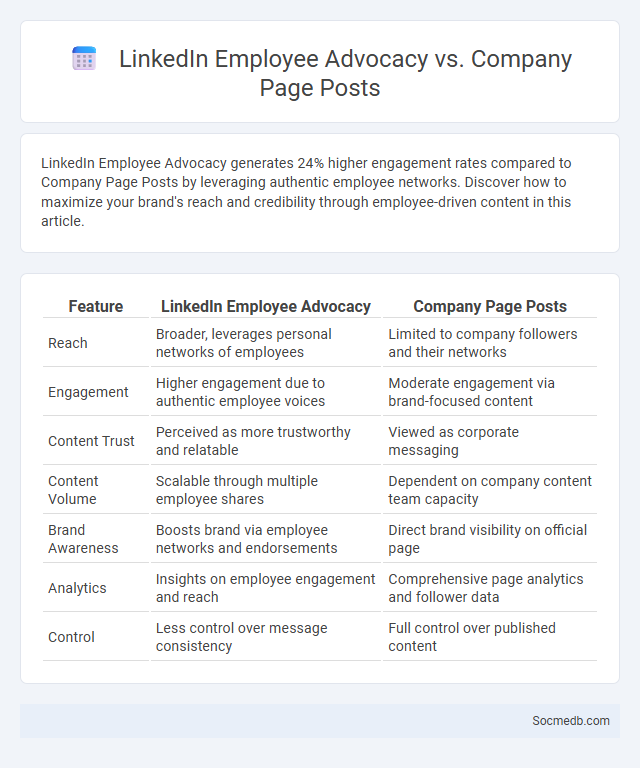
Photo illustration: LinkedIn Employee Advocacy vs Company Page Posts
LinkedIn Employee Advocacy generates 24% higher engagement rates compared to Company Page Posts by leveraging authentic employee networks. Discover how to maximize your brand's reach and credibility through employee-driven content in this article.
Table of Comparison
| Feature | LinkedIn Employee Advocacy | Company Page Posts |
|---|---|---|
| Reach | Broader, leverages personal networks of employees | Limited to company followers and their networks |
| Engagement | Higher engagement due to authentic employee voices | Moderate engagement via brand-focused content |
| Content Trust | Perceived as more trustworthy and relatable | Viewed as corporate messaging |
| Content Volume | Scalable through multiple employee shares | Dependent on company content team capacity |
| Brand Awareness | Boosts brand via employee networks and endorsements | Direct brand visibility on official page |
| Analytics | Insights on employee engagement and reach | Comprehensive page analytics and follower data |
| Control | Less control over message consistency | Full control over published content |
Understanding LinkedIn Employee Advocacy
LinkedIn employee advocacy leverages your workforce to share company content, enhancing brand visibility and credibility on the platform. By empowering employees to engage authentically, organizations boost reach and drive quality leads through trusted personal networks. Effective advocacy strategies on LinkedIn improve employer branding and foster stronger professional relationships within your industry.
What Are LinkedIn Company Page Posts?
LinkedIn Company Page posts are updates and content shared directly on your business's LinkedIn profile to engage your audience, build brand awareness, and showcase company news, job openings, or industry insights. These posts allow you to connect with followers, attract potential clients or employees, and enhance your company's online presence. Your strategic use of LinkedIn Company Page posts can significantly boost engagement and professional networking opportunities.
Employee Advocacy: Definition and Benefits
Employee advocacy leverages your workforce to promote the brand authentically on social media, amplifying reach and fostering trust among target audiences. This strategy boosts employee engagement, enhances brand reputation, and drives higher conversion rates by utilizing genuine personal endorsements. Organizations that implement employee advocacy enjoy increased organic visibility and improved recruitment outcomes through authentic online presence.
Key Differences Between Employee Advocacy and Company Page Posts
Employee advocacy involves individuals sharing authentic content about their company on personal social media profiles, fostering trust and expanding reach through personal networks. Company page posts are official communications directly from a brand's social media account, designed to maintain a consistent voice and control over messaging. While employee advocacy leverages personal influence and engagement, company page posts prioritize brand consistency and centralized content delivery.
Audience Reach: Employee Advocacy vs Company Pages
Employee advocacy significantly expands audience reach by leveraging personal networks of individual employees, which tend to have higher engagement rates and trust compared to company pages. Company pages often face algorithmic limitations and lower organic visibility, restricting exposure to new potential followers and customers. You can maximize your brand's social media presence by encouraging employees to share authentic content, thereby amplifying reach beyond the company's direct followers.
Engagement Rates: Which Strategy Wins?
Engagement rates on social media vary significantly based on platform, content type, and audience targeting, making strategic choices crucial for success. Video content typically outperforms static posts, driving higher likes, shares, and comments, while personalized interactions boost Your connection and foster community loyalty. Prioritizing consistent, data-driven content schedules combined with active audience engagement maximizes Your overall engagement rate and social media impact.
Content Authenticity: Employee Advocacy vs Company Page Content
Content authenticity significantly influences audience trust on social media, where posts shared by employees often appear more genuine compared to company page content. Your employees' personal experiences and voices create relatable, transparent narratives that resonate better with followers. Leveraging employee advocacy can amplify brand credibility and foster stronger connections than polished, corporate-produced posts on official company pages.
Brand Trust and Credibility Factors
Social media platforms significantly influence brand trust and credibility by enabling authentic customer interactions and transparent communication. Consistent positive engagement, verified profiles, and user-generated content enhance perceived reliability, fostering stronger emotional connections. Brands leveraging social proof, responsive support, and credible influencer partnerships establish trustworthy reputations that drive consumer loyalty.
Best Practices for Maximizing Advocacy and Company Posts
Maximizing advocacy and company posts on social media requires strategic content curation that resonates with your target audience, leveraging authentic employee and customer testimonials to amplify trust and engagement. Utilize data-driven insights to optimize posting schedules and tailor messages for each platform, ensuring increased visibility and interaction rates. Encouraging your team to share and interact with company content transforms passive followers into active brand advocates, significantly expanding organic reach and credibility.
Choosing the Right Approach for LinkedIn Success
Optimizing LinkedIn success requires a strategic approach centered on clear professional goals and targeted audience engagement. Crafting a compelling profile with relevant keywords enhances visibility in LinkedIn's search algorithm, attracting recruiters and potential clients. Regularly sharing insightful industry content and participating in relevant groups fosters authority and meaningful connections within your niche.
 socmedb.com
socmedb.com